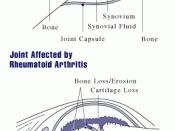Juvenile rheumatoid arthritis (JRA) is a painful condition that involves inflammation of the joints and joint pain in children under age 16. It is the most common chronic arthritis in children. Girls are affected twice as often as boys.
Some types of JRA are similar to rheumatoid arthritis, which affects adults. Although many people consider arthritis a disease of adults, children can contract most forms of arthritis. JRA affects between 30,000 and 50,000 children in the United States, according to the Arthritis Foundation.
The cause of JRA is not well understood. It is an autoimmune disease, which means the immune system attacks normal body cells in the joints. This causes inflammation and pain in the joints. Although the immune response may trigger the inflammation, it is not known what causes the immune system to do so.
JRA may affect only a few joints, frequently the knees or hips. Other types of JRA affect many joints and other systems in the body as well.
Many children with JRA have inflammations in the eyes, which require regular monitoring because they may not produce symptoms.
Physicians may use multiple blood tests and a physical examination to diagnose JRA. JRA cannot be cured although most children outgrow the symptoms when they reach adulthood. Treatment concentrates on pain relief and protecting growing joints. Drug treatment may include basic pain relievers such as anti-inflammatory drugs. Other drugs modify the disease progress or work on parts of the immune system that malfunction to trigger JRA.


